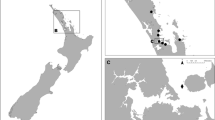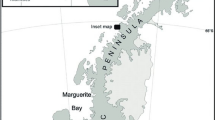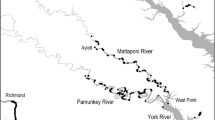Abstract
Small blue crabs (Callinectes sapidus Rathbun, 43–70 mm carapace width) can influence the size-distribution of the gastropod,Bittium varium, strongly reducing the contribution of snails >3 mm shell length in field enclosures. We test the hypothesis that these size-dependent effects are due to size-selective predation rather than size-dependent emigration from the field enclosures. In laboratory feeding trials, blue crabs showed negative selectivity for snails <2.5 mm and positive selectivity for snails >3.3 mm. When feeding, blue crabs crushBittium shells, but the opercula are deposited undamaged in the sediment. Sediment from a field enclosure experiment contained 6.5× moreBittium opercula from enclosures with blue crabs than from enclosures without blue crabs. We reconstructed the size distribution ofBittium killed by blue crabs from the opercula recovered from sediment. This distribution qualitatively matched those “missing” from the size frequency distribution of surviving snails. Estimates of selectivity from laboratory feeding trials predicted the pattern of size-selection fromBittium killed in the enclosures. We also estimated Strauss's linear index of selectivity and Chesson's α based on the size distribution of snails available during the field enclosure experiment. These indices predicted both the pattern of selectivity and the size distribution ofBittium killed in enclosures with blue crabs. We conclude that size-selective predation by blue crabs can explain the observed shifts inBittium size distributions.
Similar content being viewed by others
Literature Cited
Bell, J. D. andM. Westoby. 1986a. Importance of local changes in leaf height and density to fish and decapods associated with seagrass.Journal of Experimental Marine Biology and Ecology 104:249–274.
Bell, J. D. andM. Westoby. 1986b. Abundance of macrofauna in dense seagrass is due to habitat preference, not predation.Oecologia 68:205–209.
Blundon, J. A. andV. S. Kennedy. 1982. Mechanical and behavioral aspects of blue crab,Callinectes sapidus (Rathbun), predation on Chesapeake Bay bivalves.Journal of Experimental Marine Biology and Ecology 65:47–65.
Brooks, J. L. andS. I. Dodson. 1965. Predation, bozy size, and the composition of plankton.Science 150:28–35.
Brönmark, C., S. P. Klosiewski, andR. A. Stein. 1992. Indirect effects of predation in a freshwater, benthic food chain.Ecology 73:1662–1674.
Carpenter, S. R. (ed.). 1988. Complex Interactions in Lake Communities. Springer-Verlag, New York.
Carpenter, S. R. andJ. F. Kitchell (eds.). 1993. The trophic cascade in lakes. Cambridge University Press, Cambridge, Great Britain.
Carpenter, S. R., J. F. Kitchell, andJ. R. Hodgson. 1985. Cascading trophic interactions and lake productivity.BioScience 35:634–639.
Carpenter, S. R. andD. M. Lodge. 1986. Effects of submersed macrophytes on ecosystem processes.Aquatic Botany 26:341–370.
Chesson, J. 1978. Measuring preference in selective predation.Ecology 59:211–215.
Cooper, S. D., S. J. Walde, andB. L. Peckarsky. 1990. Prey exchange rates and the impact of predators on prey populations in streams.Ecology 71:1503–1514.
Fernandez, E., R. Anadon, andC. Fernandez. 1988. Life histories and growth of the gastropodsBittium reticulatum andBarleeia unifasciata inhabiting the seaweedGelidium latifolium.Journal of Molluscan Studies. 54:119–129.
Heck, K. L., Jr. andL. B. Crowder. 1991. Habitat structure and predator-prey interactions in vegetated aquatic systems, p. 281–299.In S. Bell, E. McCoy, and H. Mushinsky (eds.), Habitat Complexity: The Physical Arrangement of Objects in Space. Chapman and Hall, New York.
Hines, A. H., A. M. Haddon, andL. A. Wiechert. 1990. Guild structure and foraging impact of blue crabs and epibenthic fish in a subestuary of Chesapeake Bay.Marine Ecology Progress Series 67:105–126.
Howard, R. K. andF. T. Short. 1986. Seagrass growth and survivorship under the influence of epiphyte grazers.Aquatic Botany 24:287–302.
Juanes, F. 1992. Why do decapod crustaceans prefer small-sized molluscan prey?Marine Ecology Progress Series 87:239–249.
Kerfoot, W. C. andA. Sih. 1987. Predation: Direct and Indirect Impacts on Aquatic Communities. University Press of New England, Hanover, New Hampshire.
Kitting, C. 1984. Selectivity by dense populations of small invertebrates foraging among seagrass blade surfaces.Estuaries 7:276–288.
Kneib, R. T. 1991. Indirect effects in experimental studies of marine soft-sediment communities.American zoologist 31:874–885.
Krebs, C. J. 1989. Ecological Methodology. Harper and Row, New York.
Laughlin, R. A. 1982. Feeding habits of the blue crab,Callinectes sapidus Rathbun, in the Apalachicola Estuary, Florida.Bulletin of Marine Science 32:807–822.
Lodge, D. M., J. W. Barko, D. Strayer, J. M. Melack, G. G. Mittelbach, R. W. Howarth, B. Menge, andJ. E. Titus. 1988. Spatial heterogeneity and habitat interactions in lake communities, p. 181–208.In S. R. Carpenter (ed.), Complex Interactions in Lake Communities. Springer-Verlag, New York.
Martin, T. H., L. B. Crowder, C. F. Dumas, andJ. M. Burkholder. 1992. Indirect effects of fish on macrophytes in Bays Mountain Lake: Evidence for a littoral trophic cascade.Oecologia 89:476–481.
Martin, T. H., R. A. Wright, andL. B. Crowder. 1989. Nonadditive impact of blue crabs and spot on their prey assemblages.Ecology 70:1935–1942.
Nelson, W. G. 1981. Experimental studies of decapod and fish predation on seagrass macrobenthos.Marine Ecology Progress Series 5:141–149.
Orth, R. J. 1977. Effect of nutrient enrichment on growth of the eelgrassZostera marina in the Chesapeake Bay, Virginia, U.S.A..Marine Biology 44:187–194.
Orth, R. J. andJ. van Montfrans. 1984. Epiphyte-seagrass relationships with emphasis on the role of micrograzing: A review.Aquatic Botany 18:43–69.
Paine, R. T. 1976. Size-limited predation: An observational and experimental approach with theMytilus-Pisaster interaction.Ecology 57:858–873.
Paine, R. T. 1980. Food webs, linkage interaction strength, and community infrastructure.Journal of Animal Ecology 49:667–685.
Posey, M. H. andA. H. Hines. 1991. Complex predator-prey interactions within an estuarine benthic community.Ecology 72:2155–2169.
Roa, R. 1992. Design and analysis of multiple-choice feeding-preference experiments.Oecologia 89:509–515.
Sand-Jensen, K. 1977. Effect of epiphytes on eelgrass photosynthesis.Aquatic Botany 3:55–63.
Schindler, D. E., B. M. Johnson, N. A. MacKay, N. Bouwes, andJ. F. Kitchell. 1994. Crab:snail size-structured interactions and salt marsh predation gradients.Oecologia 97:49–61.
Sih, A. 1987. Predators and prey lifestyles: An evolutionary and ecological overview, p. 203–224.In W. C. Kerfoot and A. Sih (eds.), Predation: Direct and Indirect Impacts on Aquatic Communities. University Press of New England, Hanover, New Hampshire.
Sih, A., P. H. Crowley, M. A. McPeek, J. W. Petranka, andK. Strohmeier. 1985. Predation, competition and prey communities: A review of field experiments.Annual Review of Ecology and Systematics 16:269–311.
Stanhope, H. S., W. C. Banta, andM. T. Temkin. 1982. Size-specific emergence of the marsh snail,Littorina irrorata: Effect of predation by blue crabs in a Virginia salt marsh.Gulf Coast Research Report 7:179–182.
Strauss, R. E. 1979. Reliability estimates for Ivlev's electivity index, the foraging ratio, and a proposed linear index of food selection.Transactions of the American Fisheries Society 108:344–352.
Summerson, H. C. andC. H. Peterson. 1984. Role of predation in organizing benthic communities of a temperate-zone seagrass bed.Marine Ecology Progress Series 15:63–77.
Tagatz, M. E. 1968. Biology of the blue crab,Callinectes sapidus Rathbun, in the St. Johns River, Florida.Fisheries Bulletin 67: 17–33.
Thayer, G. W., W. J. Kenworthy, and M. S. Fonseca. 1984. The ecology of eelgrass meadows of the Atlantic Coast: A community profile. United States Fish and Wildlife Series. FWS/OBS-84/02.
van Montfrans, J., R. J Orth, andS. A. Vay. 1982. Preliminary studies of grazing byBittium varium on eelgrass periphyton.Aquatic Botany 14:75–89.
Virnstein, R. W. 1977. The importance of predation by crabs and fishes on benthic infauna in Chesapeake Bay.Ecology 58: 1199–1217.
Virnstein, R. W. 1979. Predation on estuarine infauna: Response patterns of component species.Estuaries 2:69–86.
Virnstein, R. W. andR. K. Howard. 1987. Motile epifauna of marine macrophytes in the Indian River Lagoon, Florida. I. Comparisons among three species of seagrasses from adjacent beds.Bulletin of Marine Science 41:1–12.
West, D. L. andA. H. Williams. 1986. Predation byCallinectes sapidus (Rathbun) withinSpartina alterniflora (Loisel) marshes.Journal of Experimental Marine Biology and Ecology 100:75–95.
Zonneveld, C. andS. A. L. M. Kooijman. 1989. Application of a dynamic energy budget model toLymnaea stagnalis (L.).Functional Ecology 3:259–278.
Author information
Authors and Affiliations
Rights and permissions
About this article
Cite this article
Wright, R.A., Crowder, L.B. & Martin, T.H. Selective predation by blue crabs on the gastropod,Bittium varium: Confirmation from opercula found in the sediments. Estuaries 19, 75–81 (1996). https://doi.org/10.2307/1352653
Received:
Accepted:
Issue Date:
DOI: https://doi.org/10.2307/1352653




